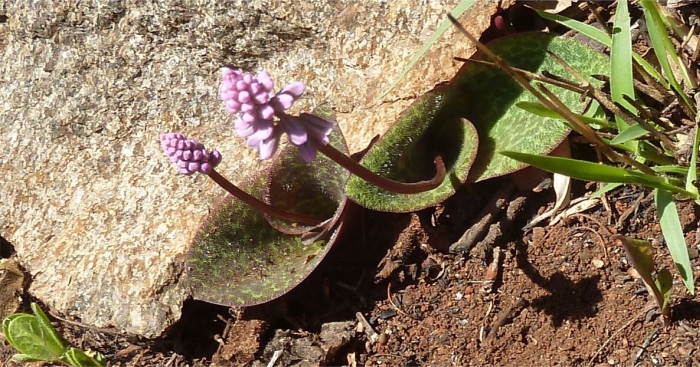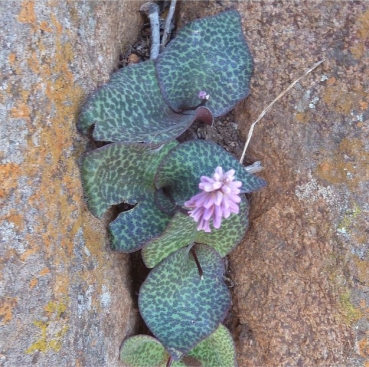Ledebouria megaphylla
Ledebouria megaphylla (Hankey ex J.M.H.Shaw) Van Jaarsv. & Eggli (= Resnova megaphylla Hankey ex J.M.H.Shaw)
Family: Hyacinthaceae
Common names: Sekhukune African hyacinth
Introduction
An attractive bulbous plant with broadly ovate, attractively spotted leaves and purple flowers in spring. The species has fast become popular in horticulture due to its highly ornamental leaves and ease of growth.

Description
Description
Medium sized bulbous plant, usually solitary or forming small groups. The white to purple-spotted bulb is approximately 40 mm long and 45 mm wide. The 2 broadly ovate leaves are produced in early summer, can be up to 140 mm long and 70 mm wide, stalkless or occasionally with a pseudopetiole (false leaf stalk), usually produced in response to low light or thick vegetation. The leaves are highly ornamental.

The upper surface is dull to silvery green and spotted with dark brownish-purple spots, with short, stiff, erect hairs located on top of raised papillae, although there are some forms that are hairless with an asperulous (rough with hard projections) upper leaf surface. The underside of the leaf is smooth and usually purple, or green with purplish, patch-like patterns. Flowers are produced in early spring (September to October). Each bulb produces a solitary, elongated inflorescence, which can be up to 250 mm long, mostly erect, becoming floppy as the fruits develop. Numerous, loosely arranged, bell-shaped, purple and whitish striped, nodding flowers (florets) are presented on a dark purple flower stalk. Each floret is comprised of 6 elongated, purple tepals (petals), and is attached by a short, purple pedicel (floret stalk). Typical of the section Resnova the flowers are unscented and the tepals only open apically creating a bell-shaped flower.

Conservation Status
Status
Ledebouria megaphylla has not been assessed for the Red List of South African plants; the species has a small area of occurrence and may be under threat due to increased mining in the area.
Distribution and habitat
Distribution description
Ledebouria megaphylla is currently only known from the Sekhukuneland area in the vicinity of Roosenekal and Tonteldoos, a very limited area of Mpumalanga, where it grows in soils derived from igneous rock, and has to date not been recorded anywhere else. The species occurs in small, low forest patches as well as between rocks and under bush-clumps in savanna. It prefers a humus-rich, loamy soil and protection from the heat of the sun, usually on southern or eastern aspects.

Derivation of name and historical aspects
History
This species was first collected by Mr Dave Hardy in 1977, and again by very few collectors, until it was independently re-discovered by the author in 1999, and given the provisional name of Resnova megaphylla, a name which had remained unpublished until 2012, when J.M.H. Shaw, a botanist from Kew validated the name. The genus Resnova was transferred to Ledebouria by J.C. Manning & Goldblatt, where the former genus Resnova is now recognised as a section of the larger genus Ledebouria. The species is named for the large leaves, mega– meaning large and –phylla, leaf (Latin). The common name Sekhukune African Hyacinth refers to the Sekhukuneland area where the species originates.
The genus Resnova was combined into Ledebouria (2004) by Prof. John Manning, who also created two sections (2012) in Ledebouria to accommodate the closely allied groups (section Drimiopsis and section Resnova) that were formerly recognised as separate genera.
The genus is named in honour of the German-Estonian botanist, Professor Carl Friedrich von Ledebour (1785–1851). South Africa has 61 species of Ledebouria, with several more species occurring across southern, western, eastern and northeast Africa and into India. The genus Ledebouria is a member of the Hyacinth Family and is well represented especially across eastern summer rainfall parts of South Africa. L. megaphylla is most closely related to L. humifusa from which it differs by the purple flowers and broadly ovate leaves.

Ecology
Ecology
As with most plants in this section of the genus, the flowers only open apically, creating a deep bell-shaped flower, this may have an influence on the size and type of pollinator which is able to effect pollination, however no pollination studies have been located for this genus or section. After pollination the swollen, green, seed capsules develop rapidly, releasing matt brown, wrinkled seeds that are released by the bursting and shriveling seed capsule. There is very little known about the ecology of the species.
Uses
Use
There is no record of this species being utilized locally by humans.

Growing Ledebouria megaphylla
Grow
This species is exceedingly rewarding and relatively easy to cultivate in any attractive container; it is ideally suited to be maintained in pots or shallow trays. The bulbs prefer a humic-rich, peaty loam potting soil with sand added to provide a well-drained base. They should be kept in morning sun to semi-shade and watered sparingly between rain showers in the summer growing season. During the dormant period in winter, the containers should be allowed to dry out, with only an occasional light surface watering to maintain some soil humidity. The emergence of the flowers in spring usually coincides with the emergence of the leaves in spring, at which time full watering can recommence.
Propagation of this species is most successful from fresh seed sown in summer. Seed can be sown directly into pots or trays filled with the sifted growing mixture and pressed lightly. The seed can be covered with a thin, 3 mm layer of fine sand or the same sifted potting mix. Germination is quick and can occur between 3-4 weeks. Seedlings can be left in their natal containers for up to 3 years or until they become too congested and then should be planted out in small clusters or as individuals into pots. Seedlings are susceptible to mealy bug below soil level, which can be treated using a systemic insecticide; damping off can occur during early establishment of the seedlings and precautions should be implemented in the form of a systemic fungicide.
References
- Hankey, A. 2003. Distinguishing between Ledebouria, Drimiopsis and Resnova. PlantLife (S. Afr.) 29: 38, 39.
- Hankey, A.J., Buys, M.H. & Lebatha, P.D. 2008. Hyacinthaceae: Drimiopsis linioseta, a new species from the Sekhukhuniland centre of endemism, South Africa. Bothalia 38,1.
- Hankey, A.J. 2019. Proposed English common names for African hyacinths (genus Ledebouria). Plantlife SA, Vol 47:7 https://plantlifesouthafrica.blogspot.com/
- Lebatha, P.D., Buys, M.H. & Stedje, B. 2006. Drimiopsis, Ledebouria and Resnova: a tale of three genera. Taxon 55: 643–652.
- Manning, J.C., Goldblatt, P. & Fay, M.F. 2004. A revised generic synopsis of Hyacinthaceae in sub-Saharan Africa, based on molecular evidence, including new combinations and the new tribe Pseudoprospereae. Edinburgh Journal of Botany 60: 533–568.
- Manning, J.C. & Goldblatt, P. 2012. Hyacinthaceae. New combinations in Ledebouria. Bothalia 42 (1): 47–48.
- Shaw, J.M.H. 2012. A new species of Resnova. CactusWorld 30(4):237-238.
- Wikipedia. Carl Friedrich von Ledebour. http://en.wikipedia.org/wiki/Carl_Friedrich_von_Ledebour. Accessed 6 November 2018.
Credits
Andrew Hankey
Walter Sisulu National Botanical Garden
April 2022
Plant Attributes:
Plant Type: Bulb
SA Distribution: Mpumalanga
Soil type: Loam
Flowering season: Spring
PH: Alkaline, Neutral
Flower colour: Purple
Aspect: Shade, Morning Sun (Semi Shade)
Gardening skill: Easy
Special Features:
Horticultural zones











Rate this article
Article well written and informative
Rate this plant
Is this an interesting plant?
Login to add your Comment
Back to topNot registered yet? Click here to register.